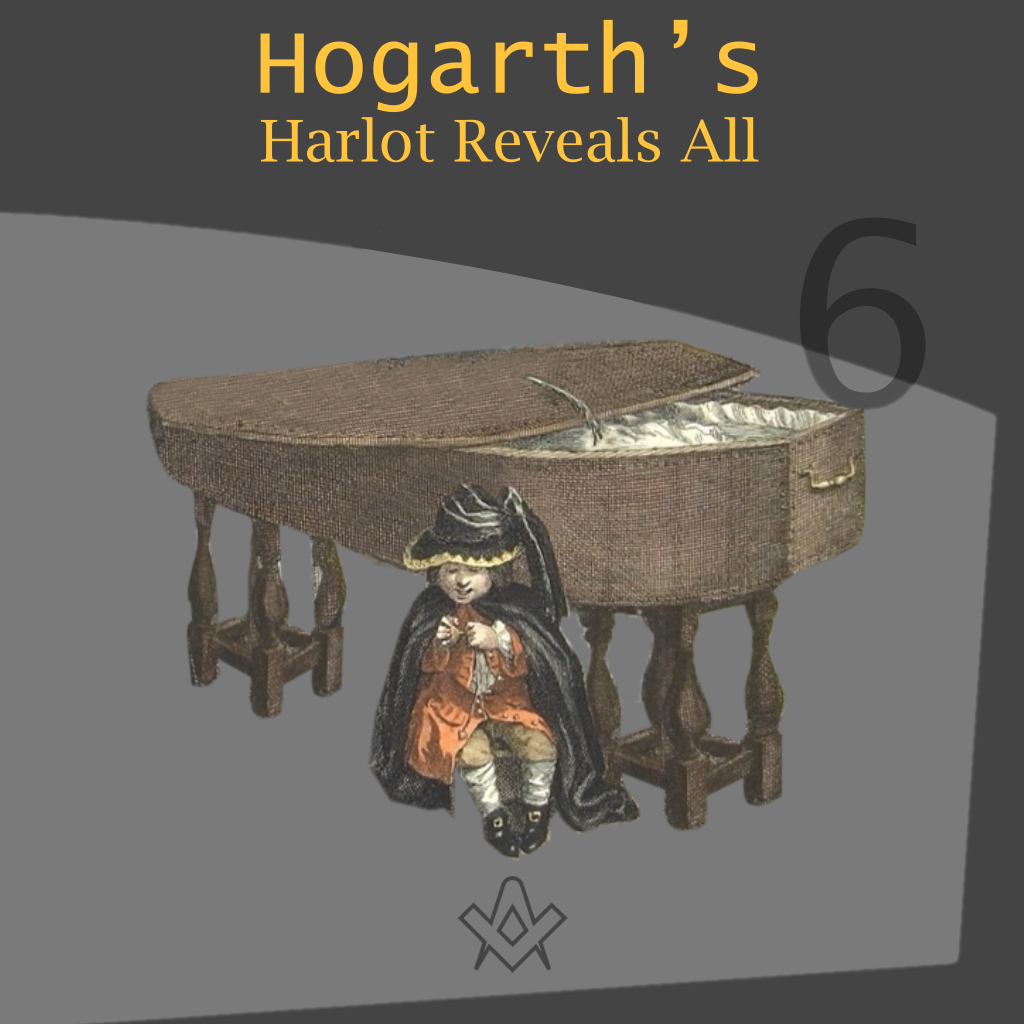We have come to the end of this sorry tale – the Harlot lies in an open casket.
A sprig of acacia, which has been placed on her coffin, seems to point in at her body.
I have isolated the coffin and acacia from Hogarth’s coloured print because these two items are found in every depiction of this Masonic ritual. Indeed, at today’s Masonic funerals you will find the same evergreen sprig resting on the casket (see figure 1).

Figure 1 – Several representations of coffins and acacia, and a modern Masonic funeral.
IMAGE CREDIT: from the author
Acacia wood has a biblical significance – it was used to make the Ark of the Covenant which rested in Solomon’s Temple.
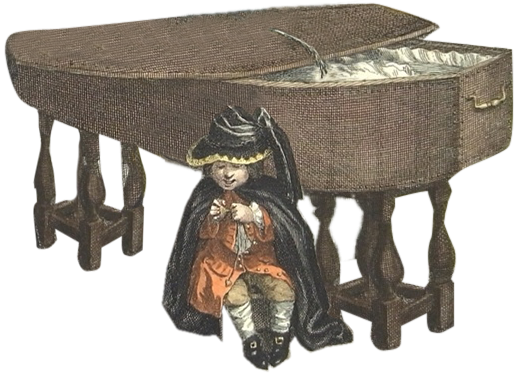
Figure 2 = The poor boy sits before his mother’s coffin
IMAGE CREDIT: A Harlot’s Progress (1731) by William Hogarth – Attribution 4.0 International (CC BY 4.0)
The Harlot’s only child mourns by her side. He is now quite destitute. Having a single mother might make you think of a ‘widow’s son’.
The words ‘widow’s son’ (along with ‘coffin’ and ‘acacia’) are mentioned many times in Duncan’s Ritual for the Third Degree (1866), and in Prichard’s Masonry Dissected (1730).
Over the last several blogs I have shown how Hogarth concealed some hand sign of Masonic ritual within each of his pictures in the series.
In this, the final scene, Hogarth has incorporated the signs of the most important degree.
First, let us take a quick recap to see how the signs in the preceding five pictures have brought us to this point.
Again, I am not revealing anything that is not in plain sight. I am only comparing the characters in Hogarth’s print to an illustration in Duncan’s Ritual Monitor (1866), along with descriptions of the signs from Prichard’s Masonry Dissected (1730) (printed just years before Hogarth painted these scenes).
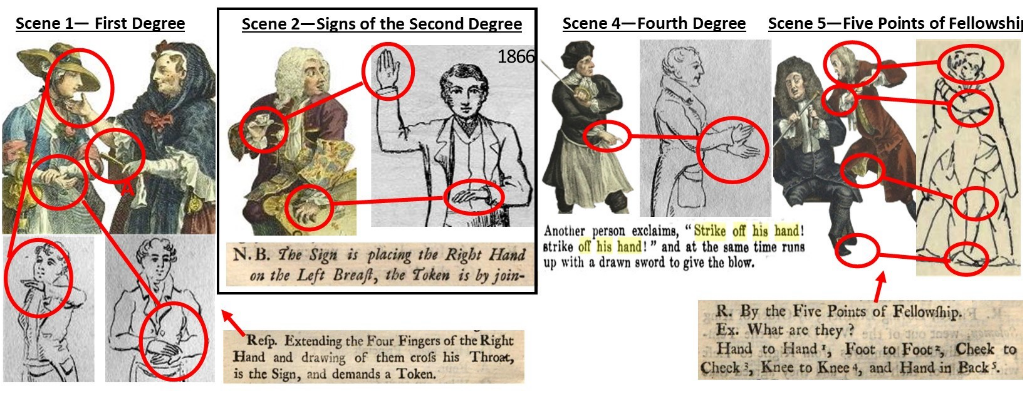
Figure 3 – Summary of the signs discussed in the previous blogs and how they match the Scene numbers.
IMAGE CREDIT: A Harlot’s Progress (1731) by William Hogarth – and Duncan’s Ritual for the Third Degree (1866) – Attribution 4.0 International (CC BY 4.0)
The signs match the relevant Scene number. 1st Degree in Scene 1, 2nd Degree in Scene 2, and what was known as the 4th degree in Scene 4.
Hogarth matched the 5 points of fellowship with Scene 5 while Scene 3 illustrated ‘labour to refreshment’.
I don’t know about you, but the sign listed as that of the Third Degree in Duncan’s Monitor looks an awful like the hand position of the prostitute in Scene 6.
She is getting help with putting her gloves on.
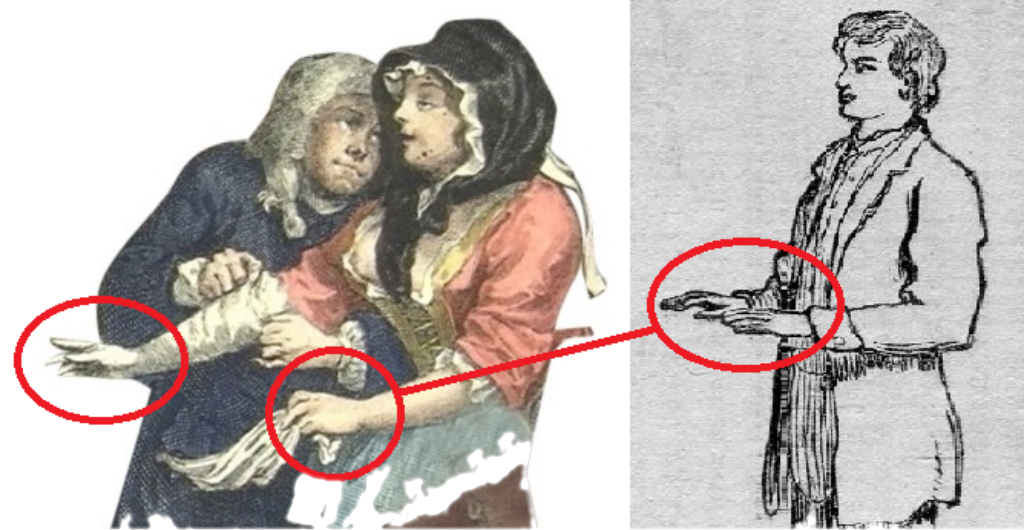
Figure 4 – 3rd degree sign from Duncan’s Monitor looks a lot like this character from the funeral
IMAGE CREDIT: A Harlot’s Progress (1731) by William Hogarth – and Duncan’s Ritual for the Third Degree (1866) – Attribution 4.0 International (CC BY 4.0)
The prostitute holds one arm out so that a man can pull on her glove. She stretches out the other arm so that she can steal his handkerchief!
This alone might be one of Hogarth’s most brilliant constructions. There is humour in this blatant theft, which is almost to be expected from one of her profession.
These prints would have been passed around the lodge room for the entertainment of the brethren.
Masons would recognise another Masonic element to this scenario – there was a tradition in the lodge that after this ceremony, the candidate would be given two pairs of gloves.
It was first mentioned in the 1600s.
Freemasons would have another laugh here, because the candidate was supposed to give the other pair of gloves to ‘the lady whom he esteems the most.’
This was meant to be your wife, but this fellow is giving them to a common whore! Observe the dreamy look he is giving her!
The brethren would enjoy another more vulgar joke when they realised how tiny the other pair of gloves were.
A second pair sit on the stool next to the enormous ‘glove stretcher’.
This implement was a euphemism for penis, because another term for the vagina was ‘the velvet glove’.

Figure 5 – The glove stretcher resembles the Mason’s compass
IMAGE CREDIT: from the author
There was another reason to include this wooden contraption. It resembled a closed pair of compasses which play an important role in the ceremony.
The other most important tool of the craft was the stonemason’s square. Hogarth has figured it within the door frame.

Figure 6 – The square is to be found in the form of the door frame which has been cleverly formed into a carpenter’s square.
IMAGE CREDIT: A Harlot’s Progress (1731) by William Hogarth – Attribution 4.0 International (CC BY 4.0)
Hogarth did not stop with the Square and Compass. He actually hid over a dozen other ‘working tools’ within the print.
Can you find the following items that are mentioned many times in Duncan’s Expose?
– setting maul (large spherical hammer with short handle)
– trowel, level, plumb,
– a rough stone, a smooth block and sprig of acacia

Figure 7 = Scene 6 – see if you can find the Tools of the Master Mason
IMAGE CREDIT: A Harlot’s Progress (1731) by William Hogarth – Attribution 4.0 International (CC BY 4.0)
Next month I will help you locate these symbols and point out more.
I will also explain one of the most explicit actions in any Hogarth print.
Artist: William Hogarth (1697-1764)
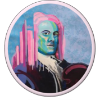
William Hogarth was made a Mason at the Hand and Apple Tree Lodge in Little Queen Street, Holborn, London c1725-28.
He later joined the Bear and Harrow in Butcher Row, known later as the ‘Corner Stone’ Lodge 4, and then Grand Steward’s Lodge. He designed a jewel known as ‘Hogarth’s Jewel’, it remained in continual use into the nineteenth century.
Hogarth was a prolific English painter whose scenes often demonstrated a satirical depiction of 18th century life.
He was responsible for the Copyright Act passed by Parliament in 1735 also known as the Hogarth Act.
Artwork: Tim Fowler
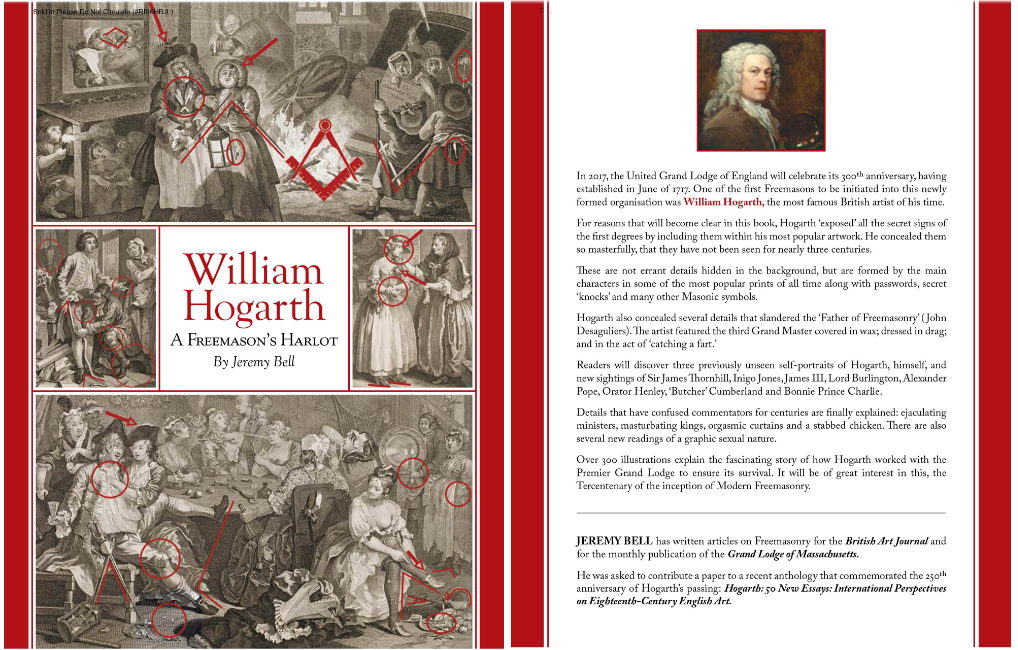
Many more details from the other scenes are explained in my book William Hogarth - A Freemason’s Harlot which is available from my website www.brotherhogarth.com.
Email me at Brotherhogarth@gmail.com. I can show you how many of Hogarth’s other works were Masonically themed.
Recent Articles: by Brother Hogarth
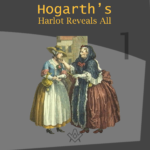 Hogarth’s Harlot Reveals All - Part 1 A new series looking at the hidden Masonic symbolism within Brother Hogarth's works - what can you find? |
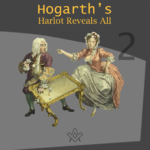 Hogarth’s Harlot Reveals All - Part 2 The second instalment in the series looking at the hidden Masonic symbolism within Brother Hogarth's works - what can you find? |
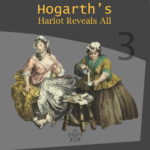 Hogarth’s Harlot Reveals All - Part 3 Brother Hogarth gives us another bawdy glimpse into the salacious world of the 'Harlot's Progress', and the tantalising Masonic symbolism hidden within! Can you spot the clues? |
 Hogarth’s Harlot Reveals All - Part 4 This month we find her in prison doing forced labour. So why, you may ask, is she dressed so finely? This sudden change of costume confused many commentators over the centuries. |
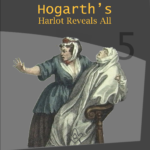 Hogarth’s Harlot Reveals All - Part 5 In last month’s instalment, our Harlot is found in prison doing forced labour. In this instalment the Harlot dies! |
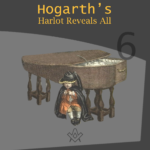 Hogarth’s Harlot Reveals All - Part 6 With our protagonist (the Harlot) lying in her casket, what next for the Widow's Son? |
 Hogarth's Harlot Reveals All - Part 6.2 A naughty clergyman, the virgin, and 'Father Time' - what can Hogarth reveal now?! |
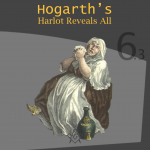 Hogarth's Harlot Reveals All - Part 6.3 Who are the famous men featured in the scene? Hogarth reveals all! |
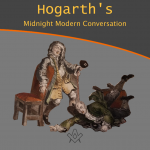 Hogarth's Midnight Modern Conversation Brother Hogarth is back with a look at another work of art with Masonic symbolism 'hidden in plain view' - what is occurring within the Midnight Modern Conversation? |
 Hogarth discreetly embeds more masonic signs and symbols in his paintings , never forgetting, everything he included in his scenes had meaning and is there for a reason. |
 Hogarth discreetly embeds more masonic signs and symbols in A Rake’s Progress, never forgetting, everything he included in his scenes had meaning and is there for a reason. |
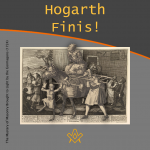 For twelve months Hogarth and his Harlot have revealed all, and the Rake has exposed himself. In this, the last part of the series (for now), we get a final glimpse at a few more of Hogarth's Masonic 'reveals'. |
masonic knowledge
to be a better citizen of the world
share the square with two brothers

click image to open email app on mobile device


